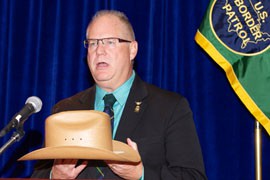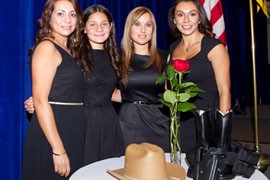Cronkite News has moved to a new home at cronkitenews.azpbs.org. Use this site to search archives from 2011 to May 2015. You can search the new site for current stories.
Arizona border patrol agent’s shooting reverberates at Washington event
WASHINGTON – The shooting death of Border Patrol agent Nicholas Ivie cast a somber cloud over an annual dinner Thursday to honor U.S. Border Patrol officers, their families and supporters.
The Border Patrol Foundation event in Washington was originally scheduled to commemorate two officers who died in July. But Ivie’s death just two days prior to the dinner refocused the thoughts of some in attendance.
Raising a cowboy hat characteristic of Border Patrol officers, retired Border Patrol Chief Ron Colburn recalled the solitude entailed in patrolling remote borderlands.
“It signifies the intellect, the independent decisiveness, the dependence we have on them, riding alone along our borders,” Colburn said. “Agent Ivie was literally riding horseback on this modern-day border in defense of our country, probably wearing a cowboy hat just like this when he lost his life.”
Ivie was killed by gunfire early Tuesday morning after he and two other agents responded to an alarm triggered by a sensor in a remote area near Bisbee.
The U.S.-Mexico border has “a couple thousand unattended ground sensors” installed according to geographic and demographic need, Colburn said.
Despite enhanced border resources following the 9/11 attacks, there have been 27 line-of-duty deaths of Border Patrol agents since 2002, nine of them in Arizona.
In the shooting that killed Ivie, a second agent was shot and wounded, but has been released from the hospital. A third agent was not injured in the incident.
The FBI said late Friday that while its investigation is continuing, there are “strong preliminary indications” that the shootings were accidental and may have involved “only the agents.”
Former Deputy Secretary of Homeland Security Paul Schneider, who was at Thursday’s dinner, said he had visited several border stations at night. While technology mitigates some of the challenges of the environment, he said the terrain and conditions are hostile.
“You have to understand how dark, difficult and dangerous it is,” Schneider said Friday. “Frankly unless you personally experience it even for a little while, it’s hard to understand.”
Homeland Security Secretary Janet Napolitano visited southern Arizona Friday to express her condolences to Ivie’s family.
Napolitano was scheduled to visit the Brian A. Terry Station, named after the last Border Patrol agent fatally shot on duty in 2010.
Border Patrol Foundation President Mike Conners said the increase in border violence makes support for surviving family increasingly important.
“I flew to Phoenix, Arizona, on July 23, 2009, to sign the papers to bring this organization into existence,” Conners said. “That evening, Robert Rosas, a border patrol agent, was killed on the border.”
Surges in border violence may be a reaction to increased law enforcement presence during the past decade, Schneider said, particularly from organizations that are frustrated by “the difficulty of penetrating U.S. defenses.”
“I think you’ll see our progress increase as people like (Border Patrol) Chief (Michael) Fisher and others start to figure out how to maximize the use of technology, infrastructure and people in developing tactics and procedures,” Schneider said.








